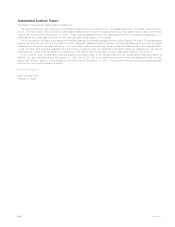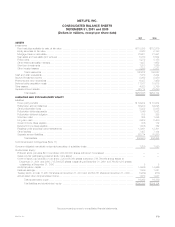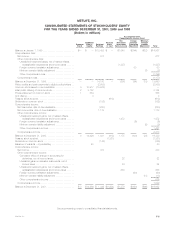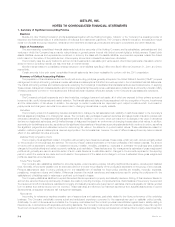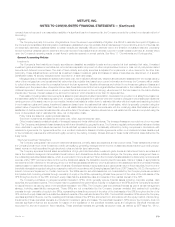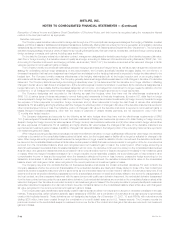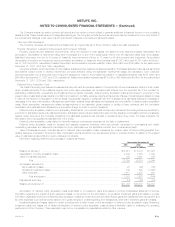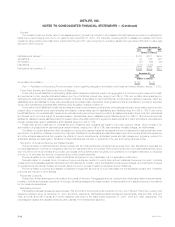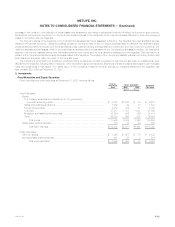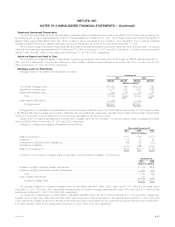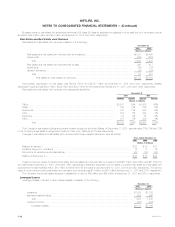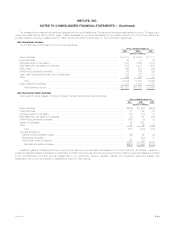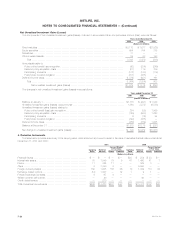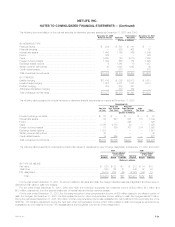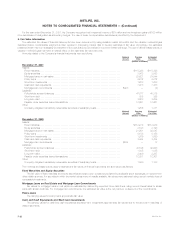MetLife 2001 Annual Report Download - page 51
Download and view the complete annual report
Please find page 51 of the 2001 MetLife annual report below. You can navigate through the pages in the report by either clicking on the pages listed below, or by using the keyword search tool below to find specific information within the annual report.
METLIFE, INC.
NOTES TO CONSOLIDATED FINANCIAL STATEMENTS — (Continued)
Goodwill
The excess of cost over the fair value of net assets acquired (‘‘goodwill’’) is included in other assets. Goodwill has been amortized on a straight-line
basis over a period ranging from ten to 30 years through December 31, 2001. The Company reviews goodwill to assess recoverability from future
operations using undiscounted cash flows. Impairments through 2001 were recognized in operating results when permanent diminution in value was
deemed to have occurred.
Years ended December 31
2001 2000 1999
(Dollars in millions)
Net Balance at January 1******************************************************************************** $ 703 $ 611 $404
Acquisitions ******************************************************************************************* 54 286 237
Amortization ******************************************************************************************* (47) (69) (30)
Dispositions ******************************************************************************************* (101) (125) —
Net Balance at December 31 **************************************************************************** $ 609 $ 703 $611
December 31,
2001 2000
(Dollars in millions)
Accumulated Amortization ****************************************************************************** $ 108 $ 81
See ‘‘— Application of Accounting Pronouncements’’ below regarding changes in amortization and impairment testing effective January 1, 2002.
Future Policy Benefits and Policyholder Account Balances
Future policy benefit liabilities for participating traditional life insurance policies are equal to the aggregate of (i) net level premium reserves for death
and endowment policy benefits (calculated based upon the nonforfeiture interest rate, ranging from 2% to 11%, and mortality rates guaranteed in
calculating the cash surrender values described in such contracts), (ii) the liability for terminal dividends, and (iii) premium deficiency reserves, which are
established when the liabilities for future policy benefits plus the present value of expected future gross premiums are insufficient to provide for expected
future policy benefits and expenses after deferred policy acquisition costs are written off.
Future policy benefit liabilities for traditional annuities are equal to accumulated contractholder fund balances during the accumulation period and the
present value of expected future payments after annuitization. Interest rates used in establishing such liabilities range from 3% to 12%. Future policy
benefit liabilities for non-medical health insurance are calculated using the net level premium method and assumptions as to future morbidity, withdrawals
and interest, which provide a margin for adverse deviation. Interest rates used in establishing such liabilities range from 3% to 11%. Future policy benefit
liabilities for disabled lives are estimated using the present value of benefits method and experience assumptions as to claim terminations, expenses and
interest. Interest rates used in establishing such liabilities range from 3% to 11%.
Policyholder account balances for universal life and investment-type contracts are equal to the policy account values, which consist of an
accumulation of gross premium payments plus credited interest, ranging from 2% to 17%, less expenses, mortality charges, and withdrawals.
The liability for unpaid claims and claim expenses for property and casualty insurance represents the amount estimated for claims that have been
reported but not settled and claims incurred but not reported. Liabilities for unpaid claims are estimated based upon the Company’s historical experience
and other actuarial assumptions that consider the effects of current developments, anticipated trends and risk management programs, reduced for
anticipated salvage and subrogation. Revisions of these estimates are included in operations in the year such refinements are made.
Recognition of Insurance Revenue and Related Benefits
Premiums related to traditional life and annuity policies with life contingencies are recognized as revenues when due. Benefits and expenses are
provided against such revenues to recognize profits over the estimated lives of the policies. When premiums are due over a significantly shorter period
than the period over which benefits are provided, any excess profit is deferred and recognized into operations in a constant relationship to insurance
in-force or, for annuities, the amount of expected future policy benefit payments.
Premiums related to non-medical health contracts are recognized on a pro rata basis over the applicable contract term.
Deposits related to universal life and investment-type products are credited to policyholder account balances. Revenues from such contracts
consist of amounts assessed against policyholder account balances for mortality, policy administration and surrender charges. Amounts that are charged
to operations include interest credited and benefit claims incurred in excess of related policyholder account balances.
Premiums related to property and casualty contracts are recognized as revenue on a pro rata basis over the applicable contract term. Unearned
premiums are included in other liabilities.
Policyholder Dividends
Policyholder dividends are approved annually by the boards of directors. The aggregate amount of policyholder dividends is related to actual interest,
mortality, morbidity and expense experience for the year, as well as management’s judgment as to the appropriate level of statutory surplus to be retained
by the insurance subsidiaries.
Participating Business
Participating business represented approximately 18% and 22% of the Company’s life insurance in-force, and 78% and 81% of the number of life
insurance policies in-force, at December 31, 2001 and 2000, respectively. Participating policies represented approximately 43% and 45%, 47% and
50%, and 50% and 54% of gross and net life insurance premiums for the years ended December 31, 2001, 2000 and 1999, respectively. The
percentages indicated are calculated excluding the business of the Reinsurance segment.
MetLife, Inc.
F-12


